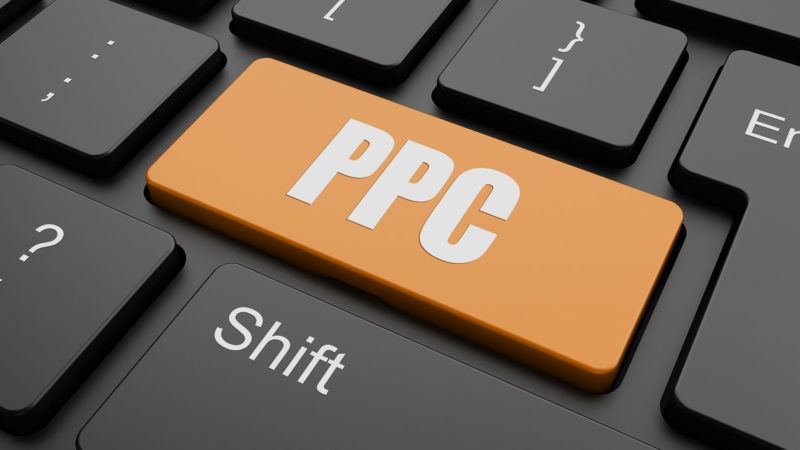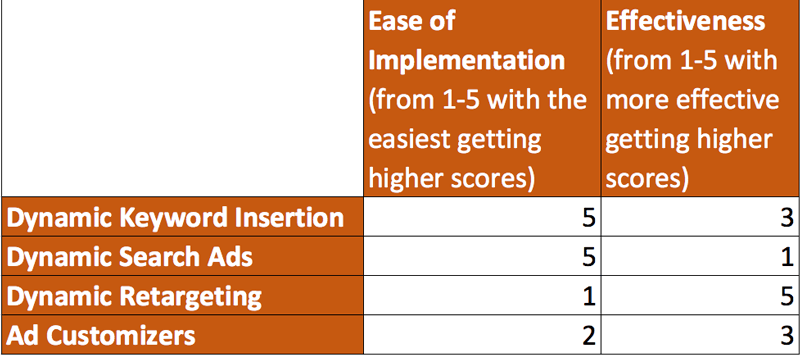Are Dynamic Ad Varieties A Waste Of Your Time?
Columnist Carrie Albright explores the various types of dynamic ads available to search marketers to help you decide which (if any) may be right for you.
Dynamic ads have been in existence for years, but both Google and Bing have recognized the need to expand this feature.
Now, in 2016, we can use dynamic keyword insertion (DKI) in our ad headlines and description lines of an ad, and the text ad creation can be automated based on the product relevance through Dynamic Search ads. And the recent use of ad customizers is a marketer’s dream, particularly as we move through seasonal promotions.
The question we’re all quietly asking, however, is this:
Should you believe the hype?
Do these dynamic ad assortments actually work? Below, you’ll find a breakdown of each dynamic ad type, including a 1–5 score on effectiveness of ad type and ease of setup (based on my own experience).
Although some of these may be quite simple to implement, they may not generate the desired successes. In contrast, some dynamic ads may require a monk’s patience but pay off with phenomenal returns in the end.
The sweet spot is the point where achievable and effective meet.
Dynamic Keyword Insertion
- Effectiveness score: 3 out of 5
- Ease of setup: 5 out of 5
Dynamic keyword insertion, or DKI, is an oldie but goodie. There are so many delicious articles about the woes of DKI or the fumbles we see in the wild, yet we still use these ad copy shortcuts regularly.
The benefit of the DKI is the immediate search-term relevance that users experience. The fact that one’s search query can appear in an ad before your eyes used to be a mind-blower. Sadly, these days, there seems to be an overuse of DKI ads created without the same level of thought and attention that non-dynamic ads receive.
After reviewing some of my agency’s e-commerce accounts, we can see that some accounts use traditional dynamic keyword insertion as much as 80 percent of the time, while others allow for fewer than five percent of text ads to use DKI.
Dynamic keyword insertion is a straightforward setup, with the rules clearly stating: If a search query matches a keyword in your inventory and falls within the character limit for that line, the keyword will be used. If these requirements are not met, a default message is shown.
As I mentioned, there are a lot of ways this can go wrong, so do your due diligence when it comes to targets, capitalization and implementation of DKIs.
But the real question is: How do these ads compare?
Below is an example client’s data, where DKI ads are used for at least five percent of the non-branded ad copy. The DKI ads are compared to a general baseline ad running during the same time.
The statistically significant data above is actually extremely surprising, considering the widely accepted view of DKI ads. The large discrepancy in conversion rates suggests that these DKIs just aren’t offering a better experience. Perhaps showing the matching keyword in one’s ad copy isn’t the fastest way to engage an audience.
Another client has a similar outcome as well: CTR actually does not improve compared to the baseline, and conversion rate sees a big improvement with the traffic that is clicking on these dynamic ads.
Although we see that visits generated from this account’s DKI ads convert more efficiently, we still have uncertainty. How frequently are ads actually taking advantage of the DKI setting? How often are the default settings showing instead?
While there is certainly more to research before unabashedly adopting DKI, we can see from the examples above that it’s not just a plug-and-play feature.
Dynamic Search Ads
- Effectiveness score: 1 out of 5
- Ease of setup: 5 out of 5
There has been a lot of coverage about the implementation of Dynamic Search Ads (DSAs), as well as their effectiveness. Because these ads are generated based on your own site’s content and inventory, they can be a real dream for an e-commerce site with a large inventory.
The setup gets a high score, in that they are extremely straightforward: Provide your website domain, select the content you’d like to target (if any) and generate the ad’s description lines. Set it and forget it! (Okay, it may be a tad more complicated than that, but not by much.)
When taking a look at our agency’s clients, I found that compared to the baseline ads, which showed product-relevant messaging but no dynamic content, Dynamic Search Ads had less than amazing results.
Client C has an alarming disconnect between the Dynamic Search Ad performance and that of our standard text ads. And whether or not the landing page choice or relevance was better when operating through DSAs, the results show us there’s a real lack in effectiveness.
With another entirely unrelated client, we see similar, though not as extreme, results. We’ve lost some type of relevance or resonance in enabling DSAs in this account.
Although these accounts have previously seen successes with Dynamic Search Ads, the past 30 days have not been kind to either of these campaigns.
While a reevaluation of targeting and exclusions is certainly warranted with these two, the message is clear: DSAs aren’t always a sure thing.
Dynamic Remarketing
- Effectiveness score: 5 out of 5
- Ease of setup: 1 out of 5
Currently, one of the most challenging remarketing features to set up, dynamic remarketing, can connect shoppers with the most relevant products to their shopper history. These ads contain one or multiple products that have been viewed by shoppers or even that complement the shopper’s previous purchase.
There are a large number of remarketing strategies that one may employ to take advantage of these new ad types. In examining a couple of accounts managed by our agency, we saw successful interaction because of these ads.
The first client ran traditional remarketing image ads alongside our dynamic ad content.
Although each has been successful, the Dynamic Remarketing ads generated a CTR that was 157 percent better than general remarketing ads. Shoppers clicked on our client’s ads nearly twice as frequently when images were either previously viewed or complementary products. That’s a huge volume of qualified visitors entering the site to resume a shopping process.
Although the conversion rate for the dynamic ads was not as strong as with the traditional remarketing ads, the loss pales in comparison to the overall volume of on-site visitors. That is to say that the dynamic ads generated 2/3 of the volume of sales at a CPA 43 percent lower than the CPA of traditional remarketing ads.
Client B experienced improved performance with dynamic ads, as well. This online retailer experienced a 44-percent lift in CTR compared to CTR on its traditional remarketing ads.
The big success, however, is the leap in conversion rate. Dynamic remarketing ads saw a nearly 70-percent boost in conversion rate. Combined with the increased CTR, the overall outcome of utilizing this new ad type was a 76-percent decrease in cost per sale, or in other terms, a 340X greater ROAS. Yowza!
So why aren’t some people using it? The biggest hindrance, coupled by the greatest value, is the setup. To use dynamic remarketing, the remarketing tag must be adapted to include visitor-specific detail. Google support provides several resources for creating your customized remarketing tag, but it can still be a cumbersome process. They also offer alternative steps, such as GTM, for a slightly simpler implementation.
Ad Customizers
- Effectiveness score: 3 out of 5
- Ease of setup: 2 out of 5
Ad customizers are some of the newer products offered by Google. Much speculation has been made about how to use ad customizers and what feature to utilize.
The ease of setup is a 2 because of the planning and layout process. Syncing features such as an account’s inventory and location listings requires creating a reference feed and assigning it to your new ad copy. Although the setup process isn’t terribly complicated, the effective use of these types of ads can be tricky.
What are your top features or products to tackle?
To answer this question, I took a look at the ad customizers we have running in a few of our agency’s accounts.
The example of Client Red utilized the inventory-synced countdowns. This was for a seasonal product that was prone to run out as the season concluded. The ads were intended to keep shoppers in a “don’t miss out” mentality. Hesitate, and they might lose their chance to own this product. Although the strategy behind these countdown ads was sound, the results were less impressive.
When testing these ads against non-countdown ads, we saw a loss in engagement when the ad copy focused its content on the remaining inventory instead of increased product description. Worse yet, the conversion rate for this traffic was inferior to the non-countdown ads, as well.
Although the intention of these customized ads is to generate a click, the lack of conversions to follow further suggest that this application of the ad still needs improvement.
Client Orange was another account that utilized ad customizers, but for geographic relevance. This client offers brick-and-mortar locations across the US, and the ad customizer feature is integrated with the Google My Business location listings.
Because we anticipate that those associated with local stores will visit the actual location, not always convert online, the CTR here is the bigger goal.
From the data above, we can see that telling a shopper of a location in their city improves CTR exponentially. Shoppers are drawn to ads that are relevant to their own lives, including where they go to shop.
The conversion rate suffered from this approach, but because of the nature of local listings, this outcome was anticipated. The next step is to continue striving for in-store attribution from online searches.
Conclusion
Here’s the round-up based on my experience:
Dynamic ads can bridge a gap between your target audience and the goods or services your business offers. Although the final outcome of these varying ad types may differ, the goal is still the same: relevant messaging for your shoppers.
Google continues to build and expand upon their dynamic features, and as they continue to do so, it will be our responsibility to find their best applications for our individual goals.
Opinions expressed in this article are those of the guest author and not necessarily Search Engine Land. Staff authors are listed here.
Related stories









